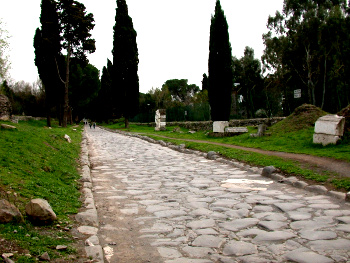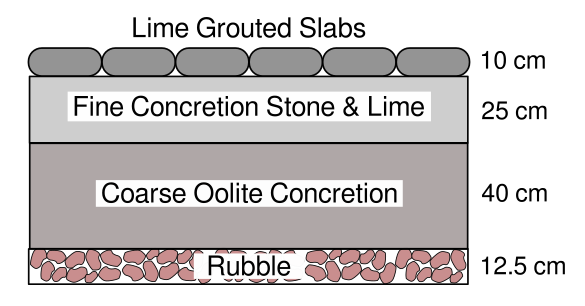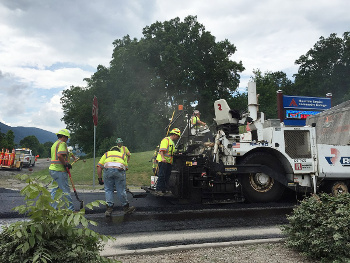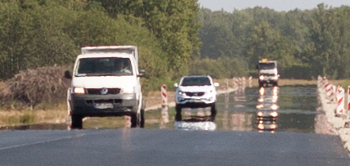Paving Materials
July 13, 2020
US President,
Dwight D. Eisenhower (1890-1969), thought that
highways were an essential part of
national infrastructure. While serving as an army general, he realized that the rapid movement of troops and their supplies was essential to national defense. That's why the US
Interstate Highway System, initially known as the Dwight D. Eisenhower National System of Interstate and Defense Highways, was created in 1956.
Since
roadways are ubiquitous, we hardly give them much thought. When we do, our thoughts tend to either
complaints about heavy
traffic, or some of the many roadway
themed jokes. My favorite of these is the
advice of
baseball great,
Yogi Berra (1925-2015), "When you come to a fork in the road, take it." He apparently said this while giving
driving directions to his
New Jersey home to fellow baseball player,
Joe Garagiola (1926-2016).[1]
There are also some
science themed roadway jokes of the
pedestrian chicken variety. For
physicists, we have a reference to
Newton's first law of motion; viz., "Chickens at rest tend to stay at rest. Chickens in motion tend to cross the road." For
biologists we have, "Why did the
dinosaur cross the road? Because chickens hadn't
evolved yet."
Synthetic materials are a recent
development, so early roadways were constructed from easily sourced
natural materials. The
Romans, with a few exceptions,[2] did little science and just incorporated the scientific ideas of the
Greeks. They did, however, excel at
engineering. While the
aqueducts are usually presented as the prime example of Roman engineering prowess, the Romans were also road builders who weren't hesitant to cut
tunnels and build
bridges to attain the
straightest possible path. The most famous Roman roadway was the
Appian Way (
Via Appia, "via" being the
Latin word for road). This roadway, begun in 312 BC, was 196
kilometers (122
miles) in length, and it connected
Rome to
Capua.

Extant portion of the Appian Way (Via Appia) in Rome.
All roadways must be carefully maintained to repair damage from weather and heavy truck traffic. In Tikalon's neighborhood, and elsewhere, the many potholes show the fragility of roadways.
Portions of the Via Appia, such as the one shown here, have existed for more than 2,000 years. It's estimated that the construction cost of the Appian Way was about two million dollars per kilometer ($3.2M per mile) in today's money.[3] This is nearly equal to today's cost of construction for two lanes of an interstate highway.
(Via Wikimedia Commons.)
The larger
Roman roads had a standard width of 4.2
meters, which was sufficient to allow two vehicles to pass each other. Road
construction used the proven technique of layering in which a coarse rubble layer (
statumen) was first applied in an
excavated trench, sometimes atop a
leveling layer of
sand, then overlaid with a coarse
concretion of small
pebbles and a
lime mortar (
rudus). Above that was a concretion of smaller
stones and
lime (
nucleus), followed by a top layer of
paving slabs slightly recessed into that lower layer and
grouted with lime (
summum dorsum). The roadway had a
crown or pitch that allowed
water flow
flow to the sides.

Roman builders used locally-sourced materials, so there are some variations in composition of the Appian Way along its route. The small stones used in the "rudus" layer above the rubble of the "statumen" were usually a type of small, fine-grained sedimentary rock called oolites. (Created with Inkscape from data in ref. 3.[3] Click for larger image.)
The layered roadway concept was improved by
John Macadam (1756-1836), who realized that
angular materials would offer a
mechanical advantage over
rounded gravel. His type of road construction, called
Macadam, specified the size of rock that could be used. Macadam said that “no stone larger than will enter a man’s
mouth should go into a road.”[3]
An important variant of a Macadam was
tarmacadam, which combined sand and
tar with Macadam surface materials. This was
patented in 1902, and the term,
tarmac, is used to describe the
paved apron of an
airport, although these are not really made from tarmacadam. Tarmac is also incorrectly used to describe
asphalt roadways. Asphalt pavement is now the preferred roadway surface covering, and it's used on more than 94 percent of the paved roads in the United States.[4]
Asphalt is a natural material that can be found in
asphalt lakes and in mixture with sand and
limestone called
rock asphalt.[4] Asphalt was used by the
Babylonians for a road material around 615
BC.[4-5] It was named άσφαλτος (asphaltos) by the
ancient Greeks, and the Romans used asphalt as a
sealant for aqueducts,
reservoirs, and
public baths.[4] It was used as a road material in the United States in the
mid-19th century, when
Belgian chemist, Edmund J DeSmedt, used lake asphalt mixed with sand to pave the street in font of the
Newark, New Jersey,
city hall, and to pave
Pennsylvania Avenue in Washington, DC.[4-5]

An all too familiar sight, road paving in the United States. This photo shows road workers paving a street in Wise County, Virginia, in 2017.
There's a joke that the road signs that state, "End Construction," are not an advisory, but rather a driver's slogan.
(Wikimedia Commons image by Famartin.)
Prior to the
20th century, most asphalt came from natural
tar pits, such as
Lake Bermudez in
Venezuela.[4] Asphalt derived from
petroleum, sometimes used as an
additive to natural asphalt, displaced natural asphalt by 1907.[4-5]
Inventor, Frederick J. Warren, was granted eight US
patents for "hot mix" paving materials in 1903, thereby taking control of the
market of asphalt as a road material.[3] The first
claim from US patent no. 727,505, "Pavement," May 5, 1903, reads,
"A street-pavement mixture composed of mineral ingredients ranging in grades from three inches down to impalpable powder, from fifty to eight per cent, of such mineral ingredients lying between one-fourth inch and three inches in diameter, in combination with a bituminous binder."[6]
A 1910
legal ruling declared that mineral sizes outside the range specified did not infringe, thereby opening the asphalt paving market.[3]
The purpose of a roadway is to allow vehicular
transportation. Our
energy-conscious and
global warming civilization is always looking for ways to reduce the energy expended by vehicles and their
greenhouse gas emissions. While
fuel efficiency is an important factor, there's also the interaction between the vehicle and the pavement.
Recent research by
engineers and
materials scientists at the
Massachusetts Institute of Technology (Cambridge, Massachusetts) has examined how an increase in the
elastic modulus of pavement surface layers will lower vehicle fuel consumption by reducing the
bending-induced pavement–vehicle interaction.[7-8] Their
research is
published in a recent issue of the
Transportation Research Record.[7]
The MIT
theoretical study shows that even a small change in the
mechanical properties of roadway pavement would eliminate a half-percent of the total greenhouse gas emissions from transportation at very little cost.[8] This would be a consequence of improved
fuel mileage for heavy vehicles that would reduce greenhouse gas emissions.[7-8] This improvement would come about by increasing the elastic modulus of resurfaced roadways of the interstate highway system, thereby reducing greenhouse gas emissions by 440
megatons carbon dioxide equivalent over a 50-year period.[7]
The
weight of heavy vehicles causes a slight deflection in the road surface, and this deflection is enough to change a truck's overall fuel efficiency.[8] The
computer model by members of the
MIT Concrete Sustainability Hub examined
climate conditions, road lengths, materials properties, and road usage, and it examined changes from pavement resurfacing.[8] The research found that stiffer pavements reduce the deflection that forces trucks to climb out of the small
hill that results from their weight.[8] Says MIT principal research scientist and
co-director of MIT's Concrete Sustainability Hub,
Randolph Kirchain,
"When we as individuals walk on pavements, they seem like perfectly rigid things. They're not responding to us... But for trucks, that is not the case. There is enough of a deflection in that surface that some amount of energy is expended to overcome the little divot that you create as you drive along."[8]
One way to reduce pavement deflection is through use of
concrete, rather than asphalt. While concrete is a common pavement material in the
Northern United States, much asphalt is used in the
South, where the higher
temperatures cause even higher deflection.[8] Additives can have a major affect, and a very small amount of
synthetic fibers or
carbon nanotubes, about a tenth percent, dramatically improves asphalt stiffness.[8] One problem is that asphalt with additives might require modification of paving machines.[8]

A mirage over a hot asphalt road. These apparitions are caused by the refraction of air, and they were a frequent sight on family summer vacation road trips of my youth. What appears as water on the roadway is actually an inverted image of the sky.
(Wikimedia Commons image by Yuri Khristich.)
References:
- Yogi Berra: When You Come to a Fork in the Road, Take It, Quote Investigator.
- The most prominent authors of Roman science are as follow:
• Lucretius (99 BC-55 BC), who wrote De rerum natura, a book about the Greek atomists, optics, and biology.
• Nigidius Figulus (c.98 BC-45 BC), who wrote about astronomy, zoology, and meteorology.
• Vitruvius (c.75BC - c.15BC), who wrote De architectura), a book about architecture, surveying, astronomy, mechanics, materials, and mathematics.
• Pliny the Elder (23-79), whose multi-volume Naturalis Historia (77 AD) contained many scientific facts, including many about minerals.
• Frontinus (c.40-103), a Roman general who wrote De aquaeductu about Roman aqueducts.
- Pavement History at pavementinteractive.org.
- History of Asphalt, National Asphalt Pavement Association.
- History Of Asphalt Roads In The US, Dykes Paving blog.
- Frederick John Warren, "Pavement," US Patent no. 727,505, May 5, 1903 (Via Google Patents).
- Hessam AzariJafari, Jeremy Gregory, and Randolph Kirchain, "Potential Contribution of Deflection-Induced Fuel Consumption to U.S. Greenhouse Gas Emissions,"
Transportation Research Record, Advanced Online Publication, June 10, 2020, https://doi.org/10.1177/0361198120926169.
- David L. Chandler, "Stiffer roadways could improve truck fuel efficiency," Massachusetts Institute of Technology Press Release, June 11, 2020
Linked Keywords: United States; President of the United States; Dwight D. Eisenhower (1890-1969); highway; nation; national; infrastructure; Interstate Highway System; road; roadway; complaint; traffic; theme (narrative); jokes; advice; baseball; celebrity; great; Yogi Berra (1925-2015); driving; New Jersey; home; Joe Garagiola (1926-2016); science; Why did the chicken cross the road; pedestrian chicken; physicist; Newton's first law of motion; biologist; dinosaur; evolution; evolved; synthetic; material; development; natural material; Roman Empire; Romans; Ancient Greece; Greeks; Roman technology; engineering; Roman aqueduct; tunnel; bridges; straigh line; Appian Way; Latin; kilometer; mile; Rome; Capua; extant; maintain; repair; damage; weather; heavy truck; Northern New Jersey; Tikalon's neighborhood; pothole; brittleness; fragility; construction; cost; dollar; inflation; today's money; lane; Wikimedia Commons; Roman roads; meter; construction; digging; excavate; trench; plane (geometry); leveling; sand; concretion; pebble; lime mortar; rock (geology); stone; lime (material); stone slab; paving slab; grout; geometric design of roads-Cross section; crown or pitch; water; fluid dynamics; flow; Roman Empire; ground track; route; sedimentary rock; oolite; Inkscape; John Macadam (1756-1836); angle; angular; classical mechanics; mechanical; rounded; gravel; Macadam; mouth; tarmacadam; tar; patent; airport apron; tarmac; paved apron; airport; asphalt; tar pit; asphalt lake; limestone; rock asphalt; Babylonia; Babylonians; Anno Domini; BC; sealant; reservoir; public bath; mid-19th century; Belgian; chemist; Newark, New Jersey; town hall; city hall; Pennsylvania Avenue in Washington, DC; road surface; road paving; Wise County, Virginia; Famartin; 20th century; Lake Bermudez; Venezuela; petroleum; additive; invention; inventor; market (economics); claim (patent); mineral; bituminous binder; law; legal; transport; transportation; conservation of energy; energy-conscious; global warming; civilization; greenhouse gas emission; fuel efficiency; engineer; materials scientist; Massachusetts Institute of Technology (Cambridge, Massachusetts); elastic modulus; deflection (engineering); bending; research; scientific literature; publish; Transportation Research Board; Transportation Research Record; theory; theoretical; mechanical properties; fuel economy in automobiles; fuel mileage; ton; megaton; carbon dioxide equivalent; weight; computer model; MIT Concrete Sustainability Hub; climate conditions; hill; director (business); co-director; Randolph Kirchain; divot; concrete; Northern United States; Southern United States; temperature; synthetic fiber; carbon nanotube; mirage; visual appearance; apparition; refraction; atmosphere of Earth; air; family; summer vacation; road trip; youth; water; inverted; sky; Lucretius (99 BC-55 BC); De rerum natura; Greek atomists; optics; Nigidius Figulus (c.98 BC-45 BC); astronomy; zoology; meteorology; Vitruvius (c.75BC - c.15BC); De architectura; architecture; surveying; applied mechanics; mathematics; Pliny the Elder (23-79); Naturalis Historia (77 AD); Frontinus (c.40-103); De aquaeductu.